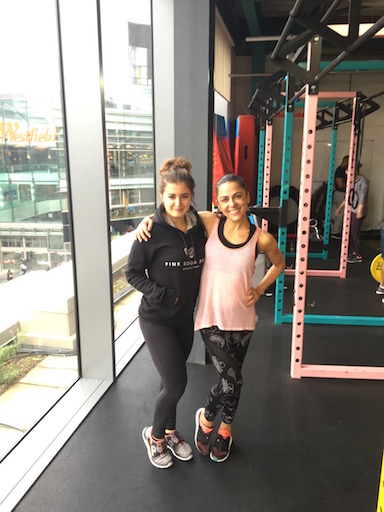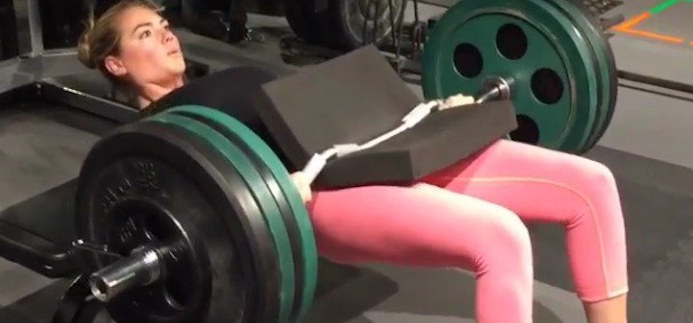Women shouldn’t lift weights? We beg to differ. After seeing ‘that’ Instagram video of Kate Upton completing a colossal deadlift without breaking a sweat, Healthista editor Anna Magee tells us how lifting weights changed her life (and body)
Kate Upton, model, actress and best known for her appearances in Sports Illustrated Swimsuit Issue put all those ‘women can’t lift’ lies to bed this week when she uploaded a video to Instagram of her lifting humungous weights with ease.
Now, Healthista’s very own, Anna Magee, tells us why she loves to lift.
‘Strength training is much more than the latest booming trend on Instagram – it’s essential to mental and physical health,’ says convert Anna Magee. Here’s her lifting story:
Strength training is much more than the latest booming trend on Instagram – it’s essential to mental and physical health
Six months ago I was having a middle aged meltdown. Juggling too many professional projects and not really knowing what to do with any of them, I wasn’t sleeping and lacking focus during the day. I felt weak and old, like I’d somehow lost my lustre. Emotionally, anything from a broken plate to a bank statement seemed to overwhelm me with panic. The treadmill running and boxing classes I was doing were exhausting me and not shifting inches from the places I wanted them shifted (waist and thighs).
So I did what any self-respecting Mid-Life-Crisis-ist would do: I got a personal trainer I couldn’t afford.

Suzi Sorokova is a 24 year old trainer at the gym I frequent, Gymbox in Stratford, East London. I picked her not only because she was the only female trainer there (I feared the Greek God-like male trainers would make me look like them) but she also had a perky butt that would rival any Kardashian.
During our first session, I expected sweat-filled jumps and burpees but got slow-refined weight lifting moves – think old-fashioned bar type squats and chin-ups. Though mortified and worried I’d bulk up, I humoured Suzi and six weeks later, I was sleeping better, felt more focused at work and my clothes were actually looser.
Six months later I have dropped a dress size, lost two inches off my hips, one inch off my waist, can squat my own body weight and at 46, have never felt more confident.
Lifting – the new running
I’m not alone in my newfound fondness for weight lifting. Strength training with weights was fourth in the American College of Sports Medicine’s fitness trend predictions for 2016 behind wearable tech, High Intensity Interval Training (HIIT) and body weight training. Look around most gyms now and you’ll notice the weights area is no longer peopled only by grunting Michelin-men but men and increasingly, women with average sized bodies looking toned and happy and doing old-fashioned lifting moves previously reserved for athletes and powerlifters such as kettle bell swings, press ups and bench press lifts.
On Instagram, the hashtag #squats has over seven million posts, #weightlifting four million and #girlswholift nearly eight million. In celebrity terms the rule seems to be if they look amazing, they’re probably lifting. Just look at the recent pics of Kate Upton, arguably one of the hottest women on the planet right now.
Trainer Micheal Ryan put Hugh Jackman, 47, on a regime of traditional lifts and bench presses to get him in shape for the latest Wolverine film and where they once did it covertly to not taint their damsel-ly images – Marilyn Monroe is said to have trained with weights while Jean Harlow used resistance bands – more Hollywood women are lifting than ever. Cameron Diaz, Jennifer Lopez, Halle Berry, and still-hot-at-65 Jane Seymour all swear by weight training.
Body benefits
If preventing middle-aged spread is on your mid-life shopping list, strength training is key. Each decade after 30, muscle declines by 3-8 per cent and because it has a higher metabolic rate than fat, the more muscle you have, the more calories you burn not only during exercise but also at rest.
‘Muscle requires blood and oxygen to be supplied to it than fat and that increases the energy expenditure the body has to do to maintain it,’ explains Professor John Brewer, head of sports and exercise science at the St. Mary’s University, Twickenham.
A 2011 paper from the ACSM called Resistance Training in Medicine asserts that muscle loss is the single greatest contributor to age-related decline in metabolism claiming that by adding just 2-4 pounds of muscle to your body you could burn 100 extra calories a day at rest (that’s 3000 calories in a month, technically enough to lose a pound).
Moreover, lifting workouts such as circuit training may burn about 200 calories while you’re doing them but unlike cardiovascular exercise such as running, they burn some 25 per cent more additional calories in the first hour following your workout and may keep your resting metabolic rate elevated by 100 calories a day for up to 72 hours afterwards.
Lifting workouts such as circuit training may burn about 200 calories while you’re doing them
It takes a surprisingly short time to build muscle. My sessions with Suzi were only twice a week, half an hour each and the results I got are borne out in the science.
One large study from the Harvard School of Public Health followed 10,500 US men aged over 40 for 12 years and found that of all the activities they did, weight training for 20 minutes three times a week had the greatest effect on preventing age-related abdominal fat.
‘Muscle builds up quickly, even from the first session of exercise when you get sore, that minor damage repairs itself and you become stronger,’ says Prof. Brewer. ‘Within two weeks you should start to see benefits.’
Weight training can also help to control blood sugar levels in patients with type 2 diabetes
Weight training can also help to control blood sugar levels in patients with type 2 diabetes and one meta-analysis concluded that resistance training should be recommended in the prevention and management of Type-2 diabetes. Moreover, it might help age related bone loss too as with age comes a decrease in estrogen in women, a hormone that helps with calcium production and studies carried out at Glasgow Caledonian University have found that strength training improved bone density in post-menopausal women.
A weight off your mind
‘Previously it was thought only aerobic exercise could deliver positive mood benefits,’ says Dr Claire Marie Roberts, a lecturer in sports psychology at Worcester University and a Team GB psychologist.
‘But we now know that resistance and weight training can have the same or better effect on the brain by increasing the production of serotonin, the brain hormone that makes us feel good.’
Resistance and weight training can have the same or better effect on the brain by increasing the production of serotonin
Research from the University of South Carolina found that women put on a twice weekly programme of resistance training had a staggering 60 per cent decrease in anxiety levels and lowered levels of irritability in only six weeks and the effect seemed best after moderate, not intense, strength training.
And while we know all forms of exercise improve depression, a review of 25 randomized controlled trials involving exercise training of depressed patients found strength training had twice the mood benefits that aerobic exercise alone had (though the best result was when patients did both).
Studies of depressed patients have also found that those who did strength training improved their sleeplessness – a key symptoms of depression – by 30 per cent.
MORE: 30 day bikini body challenge
MORE: 5 reasons you’re not losing weight
So what’s going on?
‘Strength training taps into the brain’s reward system quickly by stimulating the neural mechanisms that make people feel better which involve brain chemicals such as serotonin, dopamine and endorphins ,’ says Roberts. ‘It also enhances the blood vessels’ ability to carry oxygen to the brain which could improve mood too.’
But there’s more to it than the neurobiological explanation, Roberts believes.
‘As you lift a certain weight, achieve a full push-up or a certain number of squats that you may have thought out of your reach, you feel your body can achieve something instantly measurable,’ she says. ‘That provides instantaneous feedback to your motivation system that says: ‘hey, I managed that, what’s next – a bigger goal? Bring it on.’ It spurs you on to do more.’
People who do strength training love the thrill of achieving a lift or move they couldn’t do before, explains Roberts.
People who do strength training love the thrill of achieving a lift or move they couldn’t do before
‘That filters into other areas of their lives and changes the way they see themselves and take on challenges.’
It’s a cliché but the first time I lifted my own body weight it felt like every cell in my body was shouting, ‘Get meeeeee!’ My panic attacks have gone, my work focus has returned and somehow, whatever’s going on personally or at work, I feel I can literally carry more both emotionally and professionally.
Now, whatever’s going on personally or at work, I feel I can literally carry more both emotionally and professionally
And while I like the inch loss (okay, I love it), that feeling of focusing on what my body can do – rather than on only what it looks like – has been the greatest confidence booster of them all.
Contact Suzi Sorokova on fitbysuzi@gmail.com or find a personal trainer at the National Register of Personal Trainers
5 ways to build muscle without a trainer
The PT alternative Small Group Training is offered increasingly by personal trainers such as Matt Gleed (mattgleed@me.com) and takes on groups of three to eight people and charge £40-60 an hour (£6-10 each).
The book Your Ultimate Body Transformation Plan (Harper Thorsons £14.99) from Nick Mitchell, founder of the prestigious training company Ultimate Performance is a step-by-step guide to getting started on a weight lifting routine.
The YouTube channels BeFit and BodyRock TV offer free, varied strength programmes for just about every level and goal.
The walking booster Weighted vests help build muscle while by adding to your body weight, increasing the load you’re carrying as you walk. The Adidas Weight Vest is £129.99 from Amazon.co.uk
The small changes ‘If you’re a couch potato, starting slow with uphill walking or stair climbing will increase strength without injury,’ says Prof. Brewer. ‘The main thing is to overload the muscle so in repairing itself, it comes back stronger.’
MORE: Eat, think and train like an Olympic athlete
MORE: 10 best tasting vegan protein powders
Like this article? Sign up to our newsletter to get more articles like this delivered straight to your inbox.





















































